Definition
A peripherally inserted central catheter (PICC) infection occurs when bacteria enters the bloodstream through or around a central line catheter. A peripherally inserted central catheter is a long, thin tube that is inserted through a vein in the arm. The catheter is threaded through the arm vein until it reaches a larger vein close to the heart. Commonly called a PICC line, it is used to deliver medicine, nutrition, IV fluids, and chemotherapy.

.
If bacteria start to grow on the central line catheter, they can easily enter the blood and cause a serious infection. This can lead to a condition called sepsis, which occurs when bacteria overwhelm the body. If you suspect you have this condition, contact your doctor right away.
Causes
Bacteria normally live on the skin. Since the catheter is inserted through your skin, these bacteria will sometimes track along the outside of the catheter. From the catheter, they can get into your bloodstream.
Risk Factors
These factors increase your chances of developing this infection:
- Having a catheter for a very long time
- Having a catheter that is not coated with an antimicrobial (a substance that kills bacteria)
- Having a catheter inserted into a vein in the thigh
- Having a weakened immune system
- Being in the intensive care unit
- Having an infection elsewhere in the body or skin
Symptoms
If you have any of these symptoms, do not assume it is due to an infection. These symptoms may be caused by other conditions. Tell your doctor if you have any of these:
- Fever
- Shaking, chills
- Fast heart rate
- Redness, swelling, or tenderness at the catheter site
- Drainage from the catheter site
Diagnosis
Your doctor will ask about your symptoms and medical history and do a physical exam.
Tests may include the following:
- Blood tests and cultures—to check blood cells and to check if bacteria are present
- Other cultures— urine , sputum , and/or skin to test for infection
- Echocardiogram —to check the heart to see if bacteria reached the heart valves
Treatment
Talk with your doctor about the best treatment plan for you. Treatment options include the following:
- Antibiotics—Antibiotics are medicines used to treat an infection. The kind of antibiotic you will be given depends on which bacteria is found in your blood.
- Central line care—Often, the PICC line will need to be removed and replaced by a new catheter.
Prevention
At the Hospital
When you are getting a PICC line placed, the staff will take the following steps to reduce your risk of infection:
- Carefully choose a safe site to insert the catheter.
- Thoroughly wash their hands or use a hand sanitizer.
- Wear surgical gowns, masks, gloves, and hair coverings.
- Clean your arm with antiseptic cleanser.
- Place a sterile sheet over you.
After the PICC line is in place, the staff will:
- Thoroughly wash their hands and wear gloves before touching the catheter or changing the bandage over the catheter.
- Use an antiseptic to clean the catheter opening.
- Take precautions when handling medicine, fluid, or nutrition that will be delivered through the catheter.
- Keep the catheter in place only as long as is needed.
- Check the catheter and insertion site daily for signs of infection.
- Not allow visitors in your hospital room when the bandage is being changed.
There are also steps that you can take to reduce your risk of infection:
- Ask the staff to take every precaution to prevent an infection.
- Tell the staff right away if the bandage needs to be changed or if the site is red or sore.
- Ask everyone entering your hospital room to wash their hands. Do not allow visitors to touch your catheter.
At Home
- Follow all instructions concerning your PICC line.
- Learn how to take care of your catheter. Follow these general guidelines:
- Follow specific instructions about showering and bathing
- Before touching the catheter, wash your hands or use a hand sanitizer. Wear gloves when touching the area.
- Change bandages as directed
- Wash the catheter caps with an antiseptic.
- Do not allow anyone to touch the catheter or the tube.
- Check the insertion site daily for signs of infection, such as redness or pain.
- Call your doctor if you think you have an infection (fever, chills).
